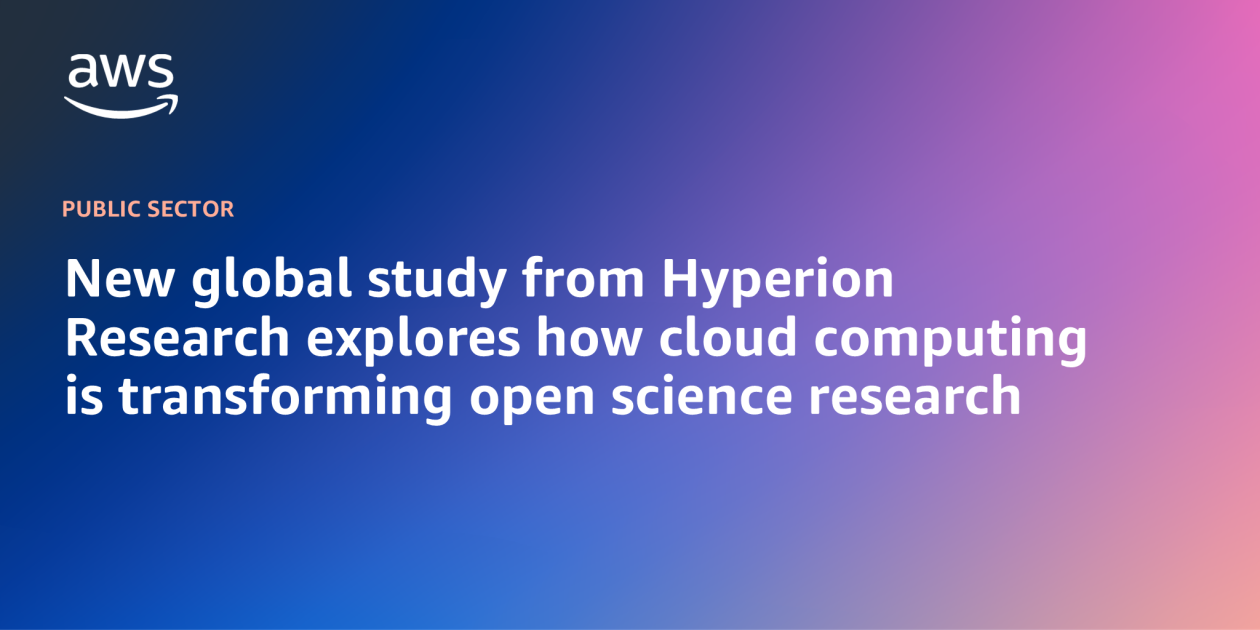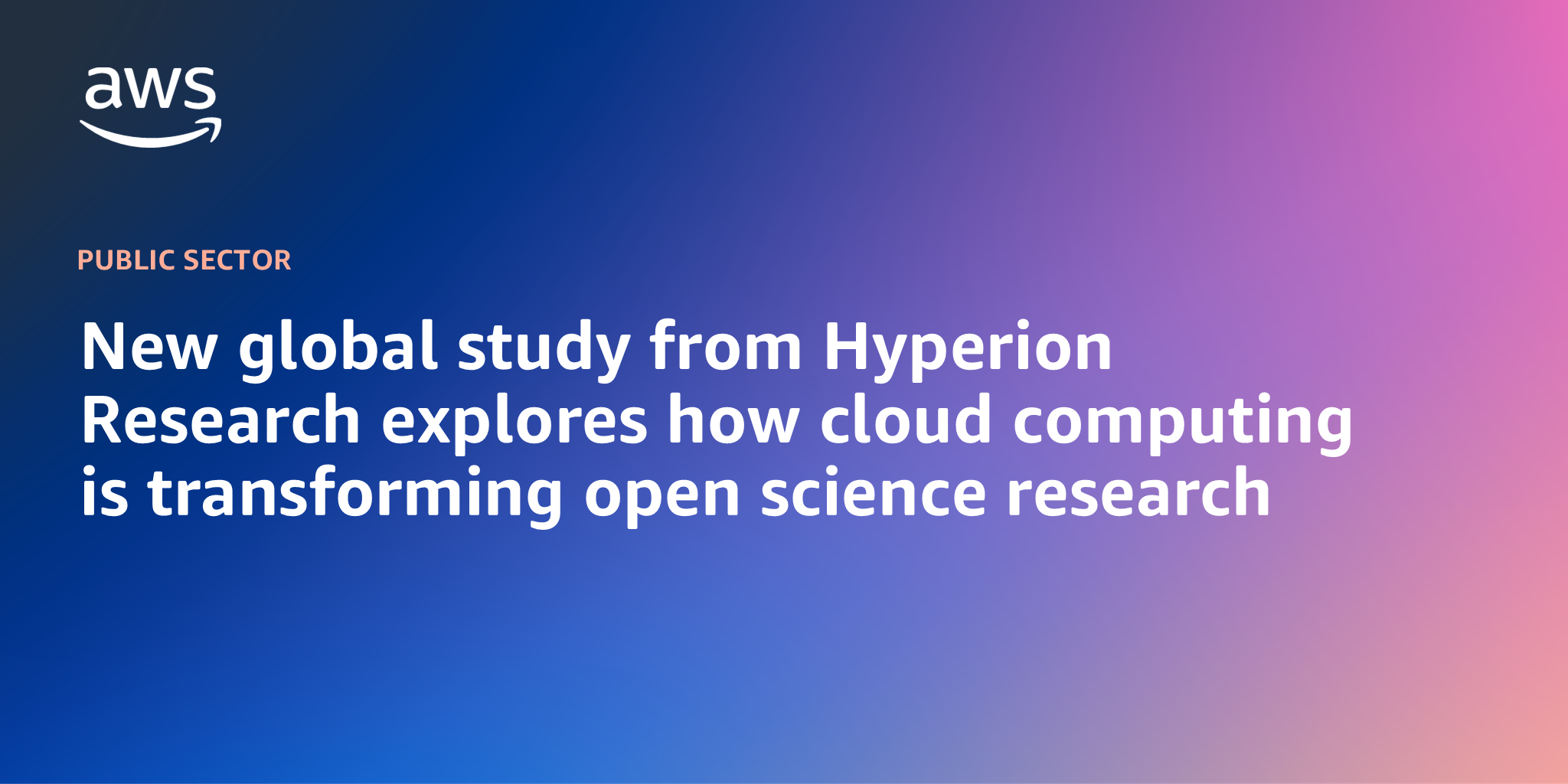In an era where scientific discovery transcends borders, cloud computing is helping advance how researchers collaborate and innovate across the globe. Now available for download, The Value of Utilizing Cloud Service Providers for Open Science Research report—produced by Hyperion Research and sponsored by Amazon Web Services (AWS)— explores how and why researchers use cloud to accelerate open science research. Drawing from the experiences of 100 researchers and research IT professionals across 88 academic, nonprofit, and government open science institutions from around the world, this study offers timely insights into the intersection of cloud computing and scientific advancement as scientific communities grapple with extraordinary computational demands from emerging technologies like generative AI and the growing need for global collaboration.
Open science refers to a set of principles and practices that aim to make scientific research from all fields accessible to everyone for the benefits of scientists and society as a whole. From astronomy to social sciences, researchers at institutions like University of California, Irvine (UCI), Genomics England, and RIKEN Center for Computational Science (R-CCS) are leveraging cloud capabilities to break down traditional barriers, make data more available, and accelerate scientific discovery. This blog will examine a few of the key findings from this report, and share an example from the University of Washington Department of Earth and Space Sciences that illustrates the themes in the study: how cloud technology is not just supporting research—it’s fundamentally reshaping how scientists collaborate, compute, and contribute to human knowledge.
Increased GPU utilization predicted
Cloud computing is dramatically expanding the horizons of scientific investigation. Researchers now have unprecedented access to advanced graphics processing unit (GPU) infrastructure and sophisticated artificial intelligence and machine learning (AI/ML) tools, enabling entirely new categories of research previously considered impossible. The Hyperion study highlights a particular finding that reinforces this trend: respondents around the globe reported a projected doubling of GPU utilization within the next 12-18 months, underscoring the accelerating pace of adoption. This technological leap is especially significant for smaller institutions, improving access to high-performance computing resources for institutions for which resources were previously difficult to obtain and leveling the playing field in scientific research.
Operational and performance enhancements
Respondents cited enhanced scalability, access to new technologies, and performance optimization among the primary drivers to conducting open science research in the cloud. Considering this in the context of what respondents reported they value most in their computational infrastructure—“to be at the leading edge of my area of research” and “to establish a competitive advantage for my institution”—the study supports the premise that access to advanced computational capabilities can lead to better grant competitiveness, talent acquisition, and academic prestige.
Implementation challenges and opportunities
Despite clear benefits, the study surfaced some of the institutional, operations, and financial factors that research institutions and researchers may face that impact, and sometimes limit, their ability to realize the benefits of cloud adoption for conducting open science research. These include reconciling traditional cost models with cloud’s strategic value proposition, managing complex legacy systems migrations, and developing essential cloud expertise. The paper highlights some of the approaches research institutions are taking to mitigate these challenges, often with the support of specialized partner solutions that complement and use cloud services to accelerate the time to scientific output. These findings suggest that successful cloud integration requires a comprehensive strategic approach that extends beyond purely technical considerations.
Global collaboration imperatives
In the study, collaboration emerged as a fundamental driver of open science success, with 85 percent of researchers emphasizing its importance across various computing environments and 70 percent specifically valuing international partnerships. Secure and compliant infrastructure is essential for protecting sensitive research data, and in the study, half of the respondents noted cloud computing’s superiority over on-premises solutions for fostering teamwork.
Strategic institutional objectives
The study affirmed that modernizing or complementing computational infrastructure through cloud adoption also plays a vital role in institutional priorities, like attracting and retaining talent. Early-career researchers increasingly expect access to advanced tools, as well as opportunities to uplevel skills through learning cloud technologies and techniques. Furthermore, the study highlights researchers’ views on the advantages of cloud environments over traditional on-premises setups for sustainability, with hyperscale data centers offering environmental benefits through renewable energy use, efficient cooling systems, and optimized computing architectures.
Cloud computing enables scientific breakthrough in global earthquake detection
A recent example that demonstrates the themes reflected in this study comes from seismology researchers at the University of Washington (UW), University of California, Davis (UC Davis), and the Earthscope Consortium Data Services, who are leveraging AWS to build the first global-scale database of primary (P) and shear (S) seismic waves arrival times (picks) on a seismogram, a process that is fundamental for earthquake detection. Using cloud-native workflows, researchers built a database of over 4.3 billion P- and S-wave picks extracted from 1.3 petabytes of continuous seismic data, demonstrating the transformative potential of cloud technology in scientific endeavors.
The project processed a petascale of global seismic data in a single day, a task that would have taken months using traditional on-premises infrastructure. This significant improvement in processing capability has enabled researchers to detect what they estimate is at least a tenfold increase in the number of earthquakes globally than anyone else, uncovering previously undetectable patterns in Earth’s seismic activity.
Marine Denolle, Associate Professor at UW, emphasizes the opportunity this opens for earth sciences research, “This will transform the way we tackle earthquake sciences with a greater focus on processes, and not be limited to places where researchers have data. Because most large and rare earthquakes still surprise us, most earthquake sequences are also novel to us. We can potentially unlock real and new understanding of these phenomena by exploring these ubiquitous processes with a global perspective, leading to fewer biases.”
Reflecting on how the value to scientific output achieved through cloud computing power reframed perceptions of cost, Denolle shares this perspective, “The perception that advanced computing comes with a high cost scares some researchers, but the benefits of cloud computing for petascale data mining make a compelling case to be incorporated into research grants. This effort demonstrated how we can crank a petascale of open data in about a day, and so now, the petascale is the new research unit. We jumped two, if not three, orders of magnitude in what is typically achievable at the researcher’s on-prem servers.”
Conclusion
Cloud computing continues to reshape the scientific research landscape across domains, including environmental sustainability, genomics, and virology, and its impact extends far beyond technological advancement. As more advanced computational resources become available, the path forward requires thoughtful integration of cloud technologies, while addressing crucial considerations of security, accessibility, and sustainability. The future of scientific discovery lies in our ability to harness these powerful cloud capabilities effectively.
Download The Value of Utilizing Cloud Service Providers for Open Science Research report to learn how this transformation is increasing access to research, accelerating discovery, and fostering unprecedented global collaboration.
About Hyperion Research
Hyperion Research provides data-driven research, analysis, and recommendations for technologies, applications, and markets in high performance computing and emerging technology areas to help organizations worldwide make effective decisions and seize growth opportunities.


